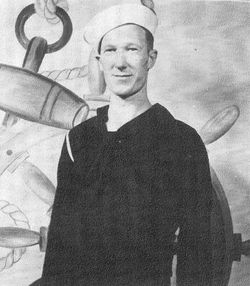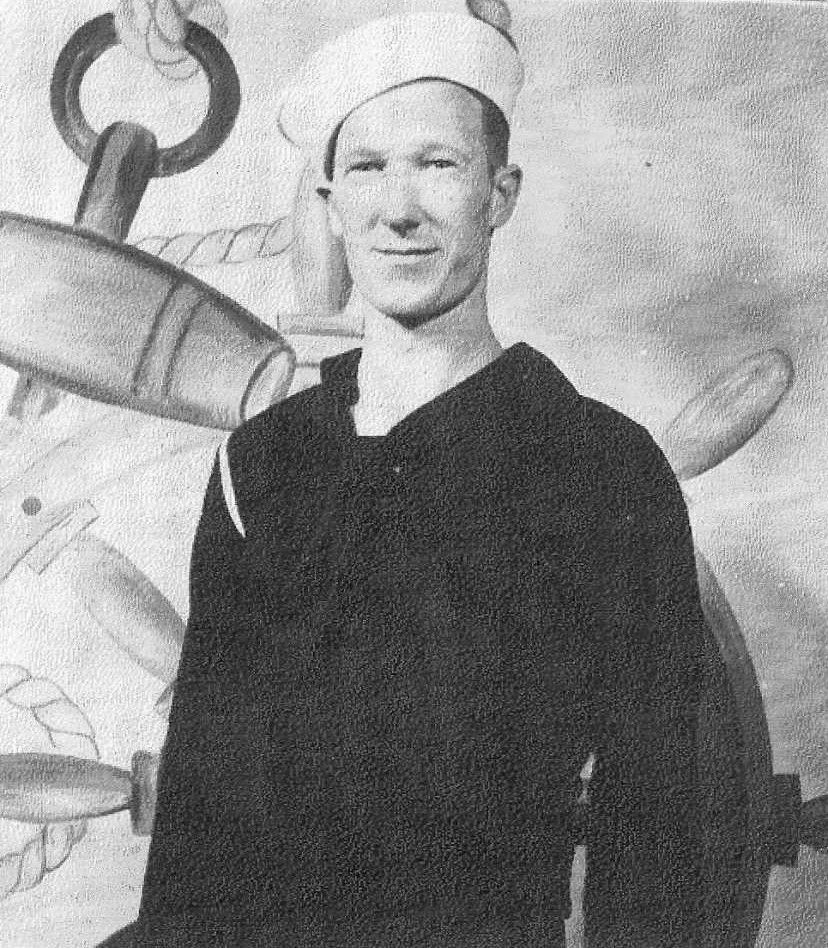Wife, Mrs. Helen Irene Johnson Rt. 2, Pleasant City, Ohio
MIA/KIA when torpedoed by Japanese submarine after delivering the components of the Little Boy atomic bomb to Tinian Island
-------------------------------------------------------------------------------------------------------
USS INDIANAPOLIS (CA-35)
Secret mission
After major repairs and an overhaul, Indianapolis received orders to undertake a top-secret mission of the utmost significance to national security: to proceed to Tinian island carrying the enriched uranium (about half of the world's supply of uranium-235 at the time) and other parts required for the assembly of the atomic bomb codenamed "Little Boy", which would be dropped on Hiroshima a few weeks later.
Indianapolis departed San Francisco's Hunters Point Naval Shipyard on 16 July 1945, within hours of the Trinity test. She set a speed record of 74+1⁄2 hours from San Francisco to Pearl Harbor, an average speed of 29 kn (54 km/h; 33 mph). Arriving at Pearl Harbor on 19 July,[19] she raced on unaccompanied, delivering the atomic bomb components to Tinian on 26 July.
Indianapolis was then sent to Guam, where a number of the crew who had completed their tours of duty were relieved by other sailors. Leaving Guam on 28 July, she began sailing toward Leyte, where her crew was to receive training before continuing on to Okinawa to join Vice Admiral Jesse B. Oldendorf's Task Force 95.
Sinking
At 00:15 on 30 July, Indianapolis was struck on her starboard side by two Type 95 torpedoes, one in the bow and one amidships, from the Japanese submarine I-58, captained by Commander Mochitsura Hashimoto, who initially thought he had spotted the New Mexico-class battleship Idaho. The explosions caused massive damage. Indianapolis took on a heavy list (the ship had had a great deal of armament and gun-firing directors added as the war went on, and was therefore top-heavy) and settled by the bow. Twelve minutes later, she rolled completely over, then her stern rose into the air and she sank. Some 300 of the 1,195 crewmen aboard went down with the ship. With few lifeboats and many without life jackets, the remainder of the crew was set adrift.
Rescue
Navy command did not know of the ship's sinking until survivors were spotted in the open ocean three and a half days later. At 10:25 on 2 August, a PV-1 Ventura flown by Lieutenant Wilbur "Chuck" Gwinn and his copilot, Lieutenant Warren Colwell, and a PBY 2 piloted by Bill Kitchen spotted the men adrift while on a routine patrol flight. Gwinn immediately dropped a life raft and radio transmitter. All air and surface units capable of rescue operations were dispatched to the scene at once.
First to arrive was an amphibious PBY-5A Catalina patrol plane flown by Lieutenant Commander (USN) Robert Adrian Marks. Marks and his flight crew spotted the survivors and dropped life rafts; one raft was destroyed by the drop while others were too far away from the exhausted crew. Against standing orders not to land in open ocean, Marks took a vote of his crew and decided to land the aircraft in twelve-foot (3.7 m) swells. He was able to maneuver his craft to pick up 56 survivors. Space in the plane was limited, so Marks had men lashed to the wing with parachute cord. His actions rendered the aircraft unflyable. After nightfall, the destroyer escort USS Cecil J. Doyle, the first of seven rescue ships, used its search light as a beacon and instilled hope in those still in the water. Cecil J. Doyle and six other ships picked up the remaining survivors. After the rescue, Marks' plane was sunk by Cecil J. Doyle as it could not be recovered.
Many of the survivors were injured, and all suffered from lack of food and water (leading to dehydration and hypernatremia; some found rations, such as Spam and crackers, among the debris of the Indianapolis), exposure to the elements (dehydration from the hot sun during the day and hypothermia at night, as well as severe desquamation due to continued exposure to salt water and bunker oil), and shark attacks, while some killed themselves or other survivors in various states of delirium and hallucinations. Only 316 of the nearly 900 men set adrift after the sinking survived.
Source: Wikipedia
Wife, Mrs. Helen Irene Johnson Rt. 2, Pleasant City, Ohio
MIA/KIA when torpedoed by Japanese submarine after delivering the components of the Little Boy atomic bomb to Tinian Island
-------------------------------------------------------------------------------------------------------
USS INDIANAPOLIS (CA-35)
Secret mission
After major repairs and an overhaul, Indianapolis received orders to undertake a top-secret mission of the utmost significance to national security: to proceed to Tinian island carrying the enriched uranium (about half of the world's supply of uranium-235 at the time) and other parts required for the assembly of the atomic bomb codenamed "Little Boy", which would be dropped on Hiroshima a few weeks later.
Indianapolis departed San Francisco's Hunters Point Naval Shipyard on 16 July 1945, within hours of the Trinity test. She set a speed record of 74+1⁄2 hours from San Francisco to Pearl Harbor, an average speed of 29 kn (54 km/h; 33 mph). Arriving at Pearl Harbor on 19 July,[19] she raced on unaccompanied, delivering the atomic bomb components to Tinian on 26 July.
Indianapolis was then sent to Guam, where a number of the crew who had completed their tours of duty were relieved by other sailors. Leaving Guam on 28 July, she began sailing toward Leyte, where her crew was to receive training before continuing on to Okinawa to join Vice Admiral Jesse B. Oldendorf's Task Force 95.
Sinking
At 00:15 on 30 July, Indianapolis was struck on her starboard side by two Type 95 torpedoes, one in the bow and one amidships, from the Japanese submarine I-58, captained by Commander Mochitsura Hashimoto, who initially thought he had spotted the New Mexico-class battleship Idaho. The explosions caused massive damage. Indianapolis took on a heavy list (the ship had had a great deal of armament and gun-firing directors added as the war went on, and was therefore top-heavy) and settled by the bow. Twelve minutes later, she rolled completely over, then her stern rose into the air and she sank. Some 300 of the 1,195 crewmen aboard went down with the ship. With few lifeboats and many without life jackets, the remainder of the crew was set adrift.
Rescue
Navy command did not know of the ship's sinking until survivors were spotted in the open ocean three and a half days later. At 10:25 on 2 August, a PV-1 Ventura flown by Lieutenant Wilbur "Chuck" Gwinn and his copilot, Lieutenant Warren Colwell, and a PBY 2 piloted by Bill Kitchen spotted the men adrift while on a routine patrol flight. Gwinn immediately dropped a life raft and radio transmitter. All air and surface units capable of rescue operations were dispatched to the scene at once.
First to arrive was an amphibious PBY-5A Catalina patrol plane flown by Lieutenant Commander (USN) Robert Adrian Marks. Marks and his flight crew spotted the survivors and dropped life rafts; one raft was destroyed by the drop while others were too far away from the exhausted crew. Against standing orders not to land in open ocean, Marks took a vote of his crew and decided to land the aircraft in twelve-foot (3.7 m) swells. He was able to maneuver his craft to pick up 56 survivors. Space in the plane was limited, so Marks had men lashed to the wing with parachute cord. His actions rendered the aircraft unflyable. After nightfall, the destroyer escort USS Cecil J. Doyle, the first of seven rescue ships, used its search light as a beacon and instilled hope in those still in the water. Cecil J. Doyle and six other ships picked up the remaining survivors. After the rescue, Marks' plane was sunk by Cecil J. Doyle as it could not be recovered.
Many of the survivors were injured, and all suffered from lack of food and water (leading to dehydration and hypernatremia; some found rations, such as Spam and crackers, among the debris of the Indianapolis), exposure to the elements (dehydration from the hot sun during the day and hypothermia at night, as well as severe desquamation due to continued exposure to salt water and bunker oil), and shark attacks, while some killed themselves or other survivors in various states of delirium and hallucinations. Only 316 of the nearly 900 men set adrift after the sinking survived.
Source: Wikipedia
Inscription
JOHNSON BERNARD J - SEAMAN 2C - USNR - OHIO
Family Members
Sponsored by Ancestry
Advertisement
Explore more
Sponsored by Ancestry
Advertisement














